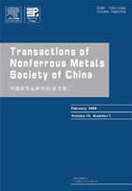Structural characteristics, tensile properties and room-temperature high-cycle fatigue properties of heterogeneous structure in near-α titanium alloys
(1. Key Laboratory of Advanced Functional Materials, Ministry of Education, Beijing University of Technology, Beijing 100124, China;
2. Chinalco Research Institute of Science and Technology Co., Ltd., Beijing 102209, China;
3. Aerospace Research Institute of Materials & Processing Technology, Beijing 100076, China)
2. Chinalco Research Institute of Science and Technology Co., Ltd., Beijing 102209, China;
3. Aerospace Research Institute of Materials & Processing Technology, Beijing 100076, China)
Abstract: A heterogeneous structure composed of elongated primary α and secondary α grains with a size of 670 nm was produced by subjecting the bimodal microstructure of a titanium alloy to hot rolling, annealing, and aging treatments. This heterogeneous structure exhibited significantly improved strength owing to a combination of heterogeneous deformation-induced strengthening and dislocation strengthening. A short-duration high-temperature heat treatment facilitated a synergistic enhancement of yield strength and elongation at both room temperature and 650 °C. The fracture elongation at room temperature and 650 °C increased by 36.7% and 130.4%, respectively, compared with that of bimodal microstructure. The stacking of geometrically necessary dislocations with a single slip system at the phase boundary and the longer effective slip length of the dislocations are the reasons for the significant improvement in elongation. The elongated primary α phase in lamellar bimodal microstructure, composed of multiple primary α grains, has better resistance to the anti-fatigue crack initiation effect.
Key words: titanium alloys; heterostructures; ductility; high-temperature deformation; heterogeneous deformation- induced strengthening

